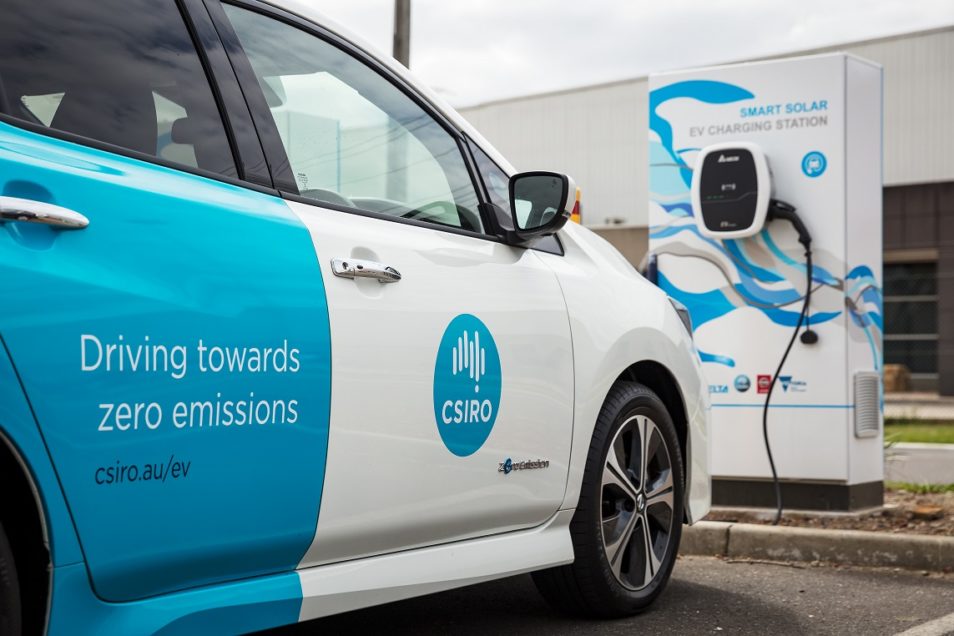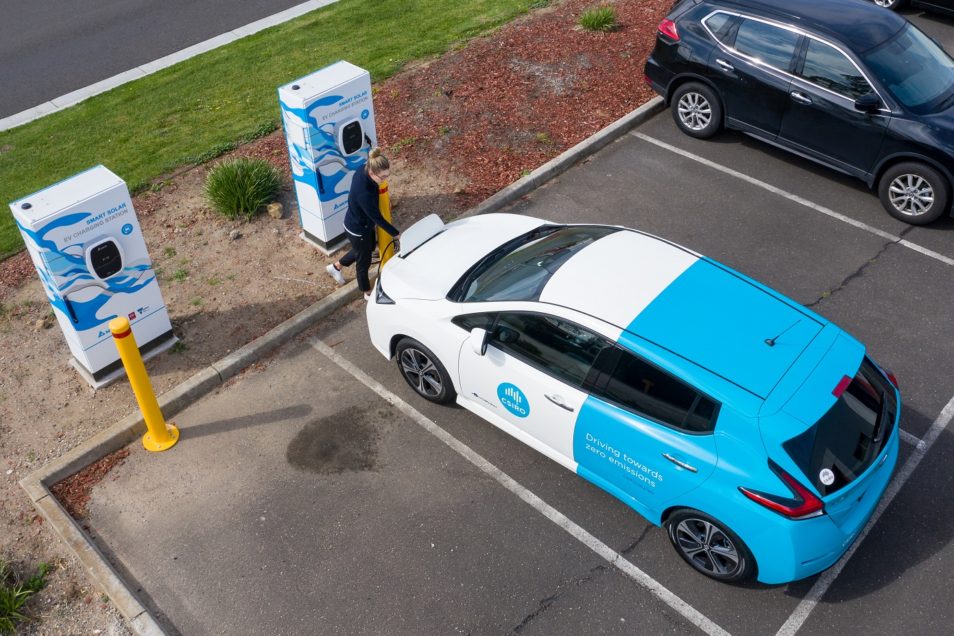
Solar panels on the building power the charging modules, which also contain a battery and our smart charging technology.
You’re cruising home after a long day at work. The orange fuel light starts blinking. It’s your car reminding you there’s only 20km left in the tank.
Traditionally, your next step would be to manoeuvre through peak hour traffic, sigh inwardly at the advertised fuel price, fill up and then be on your way… only to do it all again two weeks later. But with electric vehicles (EVs) gaining traction, this routine will change. Our new technology can help make this process even greener.
Electric vehicles plugging into solar
It’s new, it’s exciting. It’s solar-powered electric vehicle charging. This new system links your rooftop solar with a battery system and smart technology to manage the way your car is charged. Plus, it’s designed with the Australian household in mind.
There are many benefits to this system, which we’ll explain further below.
- You can power your car with home-grown renewable energy, which can also be stored for when it’s needed most.
- CSIRO-developed smart technology decides when to draw from solar, battery, or the electricity grid when your car is charging.
- You can reliably charge more than one electric vehicle at a time.
- Charging your electric vehicle in the height of summer is no sweat.

With renewable-powered charging technology, we really are driving towards zero emissions.
Clean, mean driving machine
Transport is Australia’s third-largest source of greenhouse gas emissions. And it’s increasing faster than in any other sector. Electric vehicles can make a huge impact here. They’re a cleaner option, even from using only grid power. But instead of using grid power, it makes sense we start using the power generated from Australia’s two million+ homes with solar photovoltaic panels.
You can store the solar energy you collect during the day in a household lithium-ion battery. This allows you to stash the energy away for later in the day when you plug your electric vehicle back in.
Our EV researcher Dr Christopher Munnings has done the maths and the argument for solar-powered charging stacks up. He said it’s a prime example of what’s called a ‘hybrid system.’ There we use multiple solutions (solar, battery, electric vehicle) for a positive result (lower emissions from transport). This is the type of research Chris performs in our Centre for Hybrid Energy Systems.
“Once you’re charging on renewables, the argument is pretty clear. An EV will emit less CO₂ over its lifetime than a regular internal combustion engine. If you recycle or reuse your batteries the numbers get even better,” Chris said.

It’s as easy as ‘point and shoot’, and overnight charging will become second nature.
Home is where the charge is
For most electric vehicle users, around 90 per cent of charging will be at home, meaning no peak hour detours to the servo. You’d likely go home as normal, plug the car in, and not think twice until you come back in the morning. Then your car will be charged and ready to roll – just like our mobile phones.
Australian city-dwellers drive an average of 30-40 km each day. Modern electric vehicles have a range over 250km. So, depending on your driving habits you may only need to charge an electric vehicle once or twice a week. After a while, it will become second nature to plug in daily.
What happens if we’re all charging our electric vehicles at once?
It’s possible the electricity grid could become stressed from the demand as more of us plug in our EVs each evening. This could be compounded during warm weather when the grid is under the most strain.
It’s also possible your household would want to charge more than one EV at a time with a standard grid connection. If this is the case, you’ll struggle to have enough spare power to run anything else. Like your air-conditioner, hairdryer and popcorn machine. You know, the essentials.
We’ve developed a new technology that controls when to charge your car, how quickly, and from which source (solar/battery/grid). It can also multi-task by charging up to four vehicles at a time. This is great for locations with limited grid connection, like at home, a shopping centre, or somewhere remote. This means a stress-free evening without having to reset fuses. It’s also great for the grid, which gets a smoother ride with no dramatic increases in power demand.

Our Senior Researcher Dr Christopher Munnings is plugged into all things ‘electric vehicles’.
Summertime solutions
Our electricity grid isn’t the only concern in warm weather. Often, battery systems can be less effective when the weather’s hot. When you need your car completely charged, this can quickly become an issue.
Our EV expert Chris said: “A normal household battery system is typically not powerful enough to charge a car on a hot day as it can overheat and slow down.”
“Our solar charging system can manage the temperature of the battery, minimising the amount of power required from the grid.”
“In a multi-EV home, this system will automatically monitor each car, spreading the load between the battery, solar PV and the rest of the home. This means the cars charge as quickly as possible, using as much sun as possible, without the need to upgrade grid connection.”
How do we know it works? We helped put the systems through their paces by installing three solar charging modules at Nissan Headquarters in Dandenong. Each module is capable of charging four vehicles at a time. They’ll be evaluated over 200 days, including the peak summer period. We look forward to reporting back and sharing what’s next for this exciting tech.
The project was funded by the Victorian Government and undertaken in collaboration with Delta Electronics and Nissan. Our researchers developed and tested the system and implemented the thermal management controls.


11th November 2021 at 9:26 am
Existing technology, in some Sydney homes
1)
Solar Power
2)
10 amp battery
3)
Car charging point
A Nth Beaches electrical business is installing battery charging points in 50% of renovations, some solar
A Projec home builder is including car charhing poin in new builds
26th May 2021 at 12:21 pm
Hi, how would this technology be installed?
Would it be installed post having already installed solar and battery systems?
How would a company potentially capitalise on this technology (i.e. would it be patented and licensed, or available and employable)?
Sincerely,
A student using this technology as the basis of a university assignment
8th June 2021 at 11:39 am
Hi Kaitlyn,
Thanks for your question. The technology is designed to be installed into existing solar and battery installations if they exist. Alternatively, it can also be combined with new installations and co-installed at the same time. The technology has been purpose-designed to be retrofittable, but in the first instance, it’s most likely it would be co-installed with new installations.
The technology was designed with our commercial partners, Delta and Nissan and they would control the IP and patenting where required. In terms of deployment, the concept is a unit which can be purchased from the commercialisation partners and installed via licensed electricians.
Thanks,
Team CSIRO
13th July 2020 at 5:01 pm
OWO, really a good post with valuable information. We all should be aware.
13th July 2020 at 4:54 pm
Well said. Thanks for the discussion to make us aware.
You said, charging an electric vehicle in daily will become second nature. Of course, It will be. But we need a solution.
We need a new technology in the EV that will show how much charge remains after driving. It also shows how many km we will drive with the rest of battery charge.
3rd January 2020 at 9:30 am
Critical Thinker – you make some interesting points. However as I have been driving an EV now for over 4 years I can attest that they are better to drive than a laptop – and one of the biggest benefits is that while driving I am not producing the emissions that make my asthmatic children ill to the point of needing hospitalisation.
If you were to look at history I believe you will find that every new technology has some form of advertisement – if you go to 1898 they were advertising cars as the replacement for the horse, and there will have been marketing and huge discussion around this. https://www.wired.com/2009/07/dayintech-0730/.
Historically the combustion engine was an incredible invention and moving forward new inventions wont and cant replace this achievement.
Rest assured that there are car engineers involved in the development of EVs – they are so much more than a laptop, and I believe that the research for batteries and engines is carried out by many more companies nationally and internationally than the power companies alone.
And if you haven’t driven an Electric car – give it a try – its quiet, a smooth ride and so much better than a standard automatic.